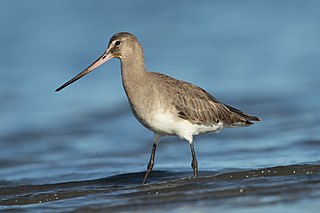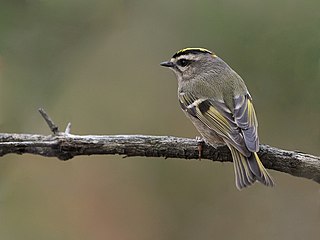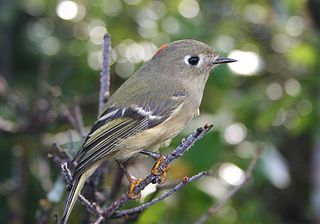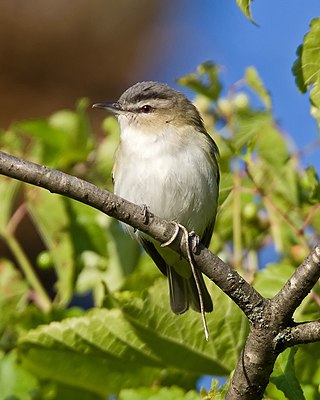
The semipalmated sandpiper is a very small shorebird. The genus name is from Ancient Greek kalidris or skalidris, a term used by Aristotle for some grey-coloured waterside birds. The specific pusilla is Latin for "very small".

The Hudsonian godwit is a large shorebird in the sandpiper family, Scolopacidae. The genus name Limosa is from Latin and means "muddy", from limus, "mud". The specific haemastica is from Ancient Greek and means "bloody". An 18th-century name for this bird was red-breasted godwit. The English term "godwit" was first recorded in about 1416–7 and is believed to imitate the bird's call.

The American tree sparrow, also known as the winter sparrow, is a medium-sized New World sparrow.

The hermit thrush is a medium-sized North American thrush. It is not very closely related to the other North American migrant species of Catharus, but rather to the Mexican russet nightingale-thrush. The specific name guttatus is Latin for "spotted".

The golden-crowned kinglet is a very small songbird in the family Regulidae that lives throughout much of North America.

The ruby-crowned kinglet is a very small passerine bird found throughout North America. It is a member of the kinglet family. The bird has olive-green plumage with two white wing bars and a white eye-ring. Males have a red crown patch, which is usually concealed. The sexes are identical, and juveniles are similar in plumage to adults. It is one of the smallest songbirds in North America. The ruby-crowned kinglet is not closely related to other kinglets, and is put in its own genus, Corthylio. Three subspecies are currently recognized.

The red-eyed vireo is a small American songbird. It is somewhat warbler-like but not closely related to the New World warblers (Parulidae). Common across its vast range, this species is not considered threatened by the IUCN.

The warbling vireo is a small North American songbird.

The yellow-throated vireo is a small American songbird.

The western wood pewee is a small tyrant flycatcher. Adults are gray-olive on the upperparts with light underparts, washed with olive on the breast. They have two wing bars and a dark bill with yellow at the base of the lower mandible. This bird is very similar in appearance to the eastern wood pewee; the two birds were formerly considered to be one species. The call of C. sordidulus is a loud buzzy peeer; the song consists of three rapid descending tsees ending with a descending peeer.

The yellow-bellied flycatcher is a small insect-eating bird of the tyrant flycatcher family.

The bay-breasted warbler is a small species of songbird in the New World warbler family, Parulidae. It is one of thirty-four species in the diverse genus Setophaga. Like all songbirds, or passerines, the species is classified in the order Passeriformes.

The Tennessee warbler is a New World warbler that breeds in eastern North America and winters in southern Central America, the Caribbean, and northern South America. The specific name peregrina is from Latin peregrinus "wanderer".

The rock wren is a small songbird of the wren family native to western North America, Mexico and Central America. It is the only species in the genus Salpinctes.

The mourning warbler is a small songbird of the New World warbler family. Mourning warblers are native to eastern and central North America as well as some countries in Central America. They are neotropical migrants and tend to be found in dense second growth forests. They are under the Wood-warbler category, which consists of arboreal and terrestrial colorful passerines. Wood warblers are in the order Passeriformes, which are perching birds including more than half of all bird species, and the family Parulidae which also includes the Common Yellowthroat, Black and White Warbler, Nashville Warbler, ovenbird, and American Redstart. They are very similar to the MacGillivray's Warbler in appearance, especially in females and immature birds, but their breeding range does not overlap into the west.

The prairie warbler is a small songbird of the New World warbler family.

The Nashville warbler is a small songbird in the New World warbler family, found in North and Central America. It breeds in parts of the northern and western United States and southern Canada, and migrates to winter in southern California and Texas, Mexico, and the north of Central America. It has a gray head and a green back, and its underparts are yellow and white.

The white-eyed vireo is a small songbird of the family Vireonidae.

The chestnut-collared longspur is a species of bird in the family Calcariidae. Like the other longspurs, it is a small ground-feeding bird that primarily eats seeds. It breeds in prairie habitats in Canada and the northern United States and winters to the south in the United States and Mexico.

The golden-crowned warbler is a small New World warbler.























